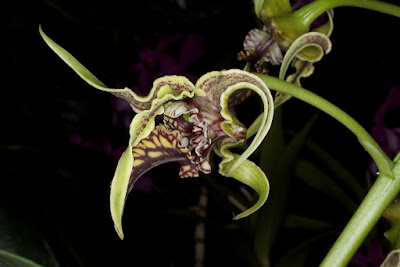Dendrobium spectabile is native to New Guinea, Bougainville, Solomon Islands and Vanuatu. They grow on trees in swampy, lowland forests, in mountain forests of the lower floor or on coconut tree plantations, on Casuarina trees, from sea level up to 1100 m...
Dendrobium spectabile also called as The Grand Dendrobium, Callista spectabilis, Dendrobium spectabile f. aurea, Dendrobium tigrinum, Latourea spectabilis, Latouria spectabilis, Latourorchis spectabile, Sayeria spectabilis, is a species of the genus Dendrobium. This species was described by Friedrich Anton Wilhelm Miquel in 1859.
IDENTIFY DENDROBIUM SPECTABILE
Dendrobium spectabile is native to New Guinea, Bougainville, Solomon Islands and Vanuatu. They grow on trees in swampy, lowland forests, in mountain forests of the lower floor or on coconut tree plantations, on Casuarina trees, from sea level up to 1100 m. In higher parts they grow on the ground in dense mosses and peat. These plants are able to survive exposure to full sun and high temperatures at lower altitudes, but grow better in colder, shady locations at higher altitudes.
It is a medium to large sized, hot growing epiphyte, occasional lithophyte, which reaching 30-122 cm in height, with semi globose at the base, to 8 noded, 30-122 cm long stems carrying to 5, towards the apex, lanceolate to ovate, coriaceous, obtuse, 20-40 cm long leaves.
The Grand Dendrobium blooms in the winter and early spring on an axillary, 20 to 40 cm long, few to 20 flowered raceme with minute, oblong bracts that arises from near the apex of leafed mature canes. The flowers are 7-8 cm in diameter. They are creamy to pale greenish, with intensely reddish brown to dark purple spots, veins and spots that do not appear on the edges. The creamy lip is yellowish with a white base. Sharp flower elements are twisted and curled.
DENDROBIUM SPECTABILE CARE AND CULTURE
Cultural information should only be used as a guide, and should be to be adapted to suit you. Your physical location; where you grow your plants, how much time you have to devote to their care, and many other factors, will need to be taken into account. Only then can you decide on the cultural methods that best suit you and your plants.
Light:
Dendrobium spectabile needs a light level of 25000-35000 lux. These plants grow well in partial shade but they should gradually be acclimated to full sun. Always ensure strong air movement.
Temperature:
It is a thermophilic plant. Throughout the year, the average day temperature is 29-32 ° C, the night 19-21 ° C, giving a daily difference of 9-12 ° C.
Humidity:
The Grand Dendrobium needs the humidity of 75-80% throughout the year. In hot weather, however, the humidity may be lower in a few afternoon hours.
Substrate, growing media and repotting:
Dendrobium spectabile can be mounted on tree ferns or cork or grown in pots with any loose, airy, quickly drying substrate. Repotting can be done at any time as soon as you see the growth of new roots. These plants grow well in tree fern pots that quickly drain water.
Watering:
Precipitation is moderate for most of the year, but the conditions are slightly drier from late fall to spring. The plants should be allowed to dry slightly between subsequent waterings, but they should not be dry for a longer period of time.
Fertilizer:
This species should be fertilized every week with 1/4 to 1/2 of the recommended dose of fertilizer for orchids. The balanced fertilizer should be applied every week or every two weeks throughout the year.
Rest period:
In winter, Dendrobium spectabile should be slightly reduced in water, especially those grown in the conditions of a short, dark day, but it can never be allowed to dry completely. Fertilization in winter should be reduced.















Is this a slow grower to bloom? How many canes must it have before it has its first bloom spike? I’m trying to gauge how many years it will take before this plant (just purchased and it had three small canes) starts to produce flower spikes.
ReplyDeleteGrown in hanging basket with mostly inert medium for drainage, in zone 9b, Port St Lucie Florida. Growing outdoors year round in open sunlight, very little or partial shade. Plant is acclimating to full sun during our winter.
Thank you.